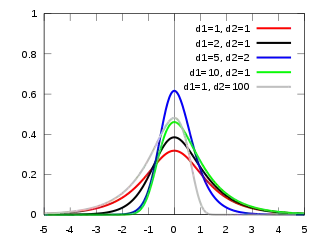Fisher's z-distribution
Fisher's z-distribution is the statistical distribution of half the logarithm of an F-distribution variate:
|
Probability density function  | |||
| Parameters | deg. of freedom | ||
|---|---|---|---|
| Support | |||
| Mode | |||

Ronald Fisher
It was first described by Ronald Fisher in a paper delivered at the International Mathematical Congress of 1924 in Toronto.[1] Nowadays one usually uses the F-distribution instead.
The probability density function and cumulative distribution function can be found by using the F-distribution at the value of . However, the mean and variance do not follow the same transformation.
The probability density function is[2][3]
where B is the beta function.
When the degrees of freedom becomes large () the distribution approaches normality with mean[2]
and variance
Related distribution
- If then (F-distribution)
- If then
References
- Fisher, R. A. (1924). "On a Distribution Yielding the Error Functions of Several Well Known Statistics" (PDF). Proceedings of the International Congress of Mathematics, Toronto. 2: 805–813. Archived from the original (PDF) on April 12, 2011.
- Leo A. Aroian (December 1941). "A study of R. A. Fisher's z distribution and the related F distribution". The Annals of Mathematical Statistics. 12 (4): 429–448. doi:10.1214/aoms/1177731681. JSTOR 2235955.
- Charles Ernest Weatherburn (1961). A first course in mathematical statistics.
External links
This article is issued from Wikipedia. The text is licensed under Creative Commons - Attribution - Sharealike. Additional terms may apply for the media files.